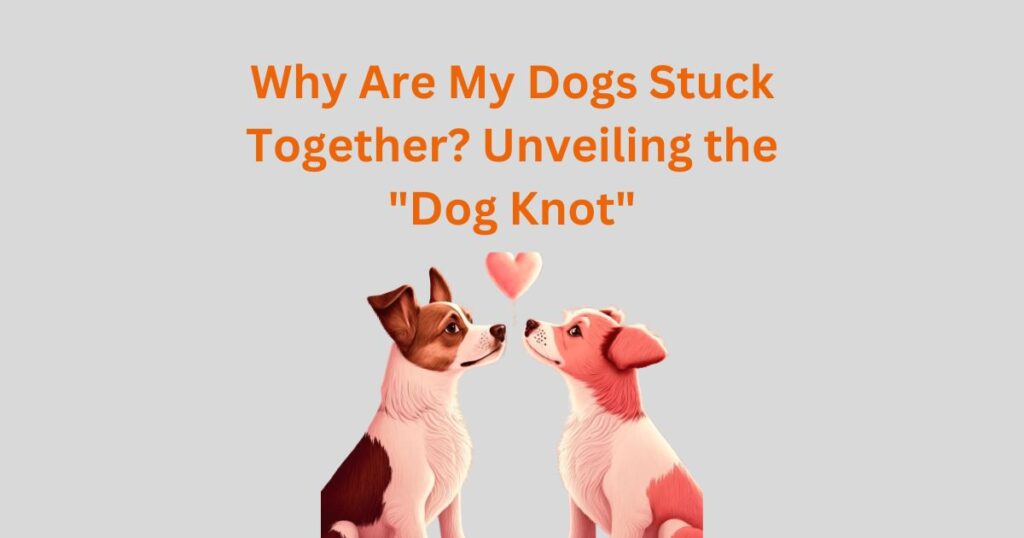It’s a beautiful Saturday morning, and as you sip your cup of coffee, you gaze out the window at your pet German Shepherds playing in the yard. Suddenly, you notice something strange – they seem stuck together at their hind ends. If you’re unfamiliar with the intricacies of canine reproduction, this dog knot sight could leave you startled.
Don’t panic! What you’re witnessing is entirely natural and is commonly known as a ‘dog knot’ or ‘canine tie.’ This article will delve into the specifics of dog knotting, demystify this often misunderstood aspect of canine behavior, and even offer some tips on what to do if your dog gets into a dog knot.
Read Also: The Ultimate Guide to Decoding Your Dog’s Behavior
What is a Dog Knot?
A dog knot, also known as a ‘copulatory tie,’ is a natural occurrence in canine reproduction. The term’ knot’ refers to a particular part of a male dog’s anatomy. In scientific terms, the knot is the bulbis glandis, a part of a dog’s penis. When a male dog mates with a female, this dog knot swells up to lock (or ‘tie’) the two dogs together for a duration ranging from 5 to 40 minutes, though it can sometimes extend up to an hour.
Why Does a Copulatory tie Happen?
The copulatory tie is an evolutionary adaptation that increases the chances of successful reproduction. By locking together, the male dog is ensured a greater chance of his sperm successfully reaching the female’s eggs. This also prevents other males from mating with the female immediately after, ensuring his genes have the best chance of being passed on.
The Canine Reproduction Process and the Copulatory tie
The mating process in dogs involves several stages:
Proestrus: This initial phase of the female dog’s heat cycle lasts approximately nine days. During this period, males will be attracted to the female, but she will not be receptive to them.
Estrus: Lasting around nine days, this is when the female is most receptive to mating, and a copulatory tie can occur.
Diestrus: This phase lasts about 60 days; during this time, the female will no longer be interested in mating.
Anestrus is the resting stage between heat cycles and can last several months.
When a female is in the estrus phase, and a male dog mounts her, he will typically thrust for a few minutes before the bulbis glandis starts to swell, leading to the ‘copulatory tie.’
The Risks of a Copulatory tie
While the canine tie is a natural occurrence, it has risks. Most notably, there is the potential for injury if one or both dogs panic while knotted and attempt to separate forcefully. Additionally, unexpected pregnancies can occur if canine tie without being supervised, which can lead to issues if the dogs are not of suitable age, health or if they are closely related.
What to Do if Your Dogs Are in a Copulatory tie
If you discover your dogs in a copulatory tie also know as “dog knot”, it’s important to remain calm. Here are some steps to follow:
Do not try to separate them forcibly: This can cause severe injury to both dogs.
Keep them calm: Speak to them soothingly, and consider covering them with a blanket.
Wait it out: The dog knot will naturally break when the swelling reduces.
Consult a vet if needed: If the dog knot lasts longer than an hour or you notice any signs of distress or pain, contact a vet immediately.
Preventing Unwanted Copulatory tie
If you do not want your dogs to breed, you should consider having them spayed or neutered. Alternatively, you can separate unneutered dogs of opposite sexes, particularly when the female is in heat.
Spaying and Neutering to Prevent Copulatory tie
Spaying or neutering your dogs is the most effective way to prevent unwanted dog knots. Apart from this, spaying and neutering also have health benefits, like reducing the risk of certain cancers and eliminating the possibility of pyometra in females.
Managing Dogs in Heat to Avoid Copulatory tie
If you have a female dog that you don’t want to spay, it’s essential to manage her heat cycles carefully to avoid copulatory tie. This includes keeping her away from intact males and possibly using dog diapers to help manage the discharge during this time.
Conclusion
While seeing a dog knot might initially be surprising, it’s an entirely natural part of canine reproduction. Understanding this aspect of your pet’s behavior can help you ensure their well-being and manage their reproductive health effectively.
Whether you’re a breeder, a pet owner with a curious mind, or someone who woke up to the surprise of a dog knot one morning, it’s crucial to handle these situations with care and knowledge. The more we understand our dogs, the better we can care for them, ensuring they lead happy, healthy lives.
Remember, if you’re ever in doubt about your dog’s health or behavior, particularly related to dog knots, it’s always best to consult a veterinarian. Their expert advice can guide you through any uncertainties, providing both you and your pet peace of mind.
